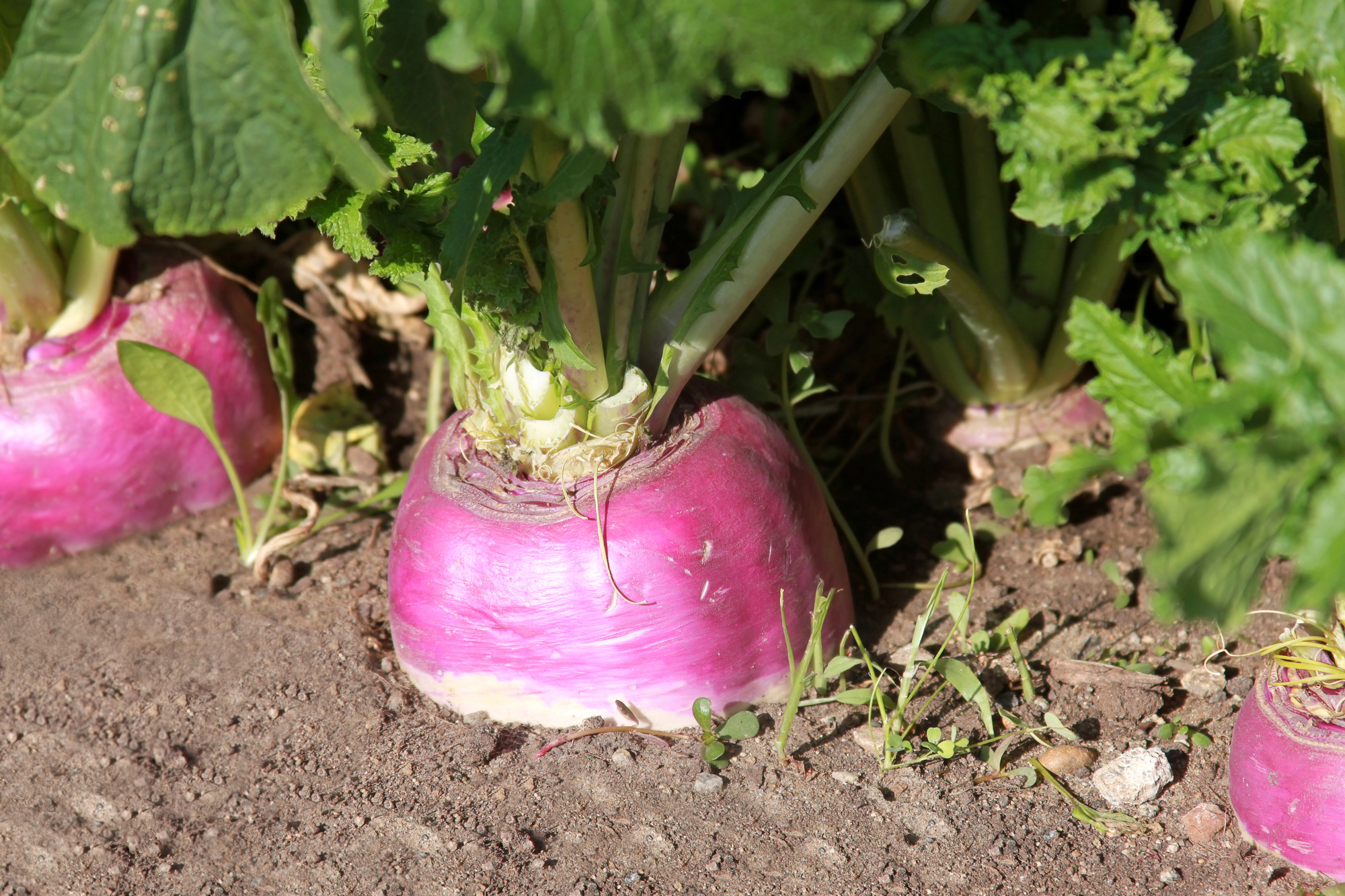Turnip Donation Tracker
Quick Links: How & Where to Grow | Temperature | How to Care For | Harvest Signs | Harvesting | Pests | Companions | Flavor | Preservation | Recipes | Michigan Tips | Fun Facts
🌱 How & Where to Grow Turnips:
- Direct sow seeds ¼-½ inch deep when soil reaches 40°F (late March-April for spring, mid-June to mid-July for fall).
- Space seeds 2 inches apart in rows 12-18 inches apart.
- Thin seedlings to 4-6 inches when they reach 4 inches tall – don’t waste those thinnings, they make excellent microgreens!
- Sunlight: Full sun (6-8 hours of direct sunlight).
- Soil Type: Turnips prefer well-drained soil with a pH of 6.0 to 6.5.
- Soil Amendment: Amend the soil with compost to improve fertility and drainage, especially in heavy clay soils
For continuous harvest, succession plant every 2 weeks through spring and resume in mid-summer for fall crops.
🌡️ Temperature Guidance:
Optimal growing: 60-65°F.
- Spring planting at 40°F soil temp;
- Fall planting at 50-60°F.
- Turnips are remarkably cold-hardy and actually develop better flavor in cool weather.
- They’ll germinate in soil as cold as 40°F but grow faster at 50-60°F.
Hot weather above 75°F causes them to become woody and bitter – this is why Michigan’s climate is perfect for two growing seasons!
💧 How to Care for:
- Consistent Moisture: Keep the soil consistently moist, but not soggy.
- Watering: Water at least one inch per week, or more frequently if the soil is sandy.
- Mulch: Heavily mulch to retain moisture and suppress weeds.
- Fertilizer: Turnips generally don’t require much fertilizer, but if the soil is poor, you can mix a little compost in before planting.
- Boron: Pay attention to boron levels in the soil, as a lack of boron can cause hollow or brown turnips.
📏 Harvest Signs:
2-4 inches diameter, shoulders visible above soil.
- Fall turnips sweeter after frost.
- The tops of turnips will push up out of the soil when ready – you’ll see their “shoulders” peeking out.
- Baby turnips at 2 inches are tender enough to eat raw, while larger ones are perfect for cooking.
Don’t let them exceed 4-5 inches or they’ll become pithy and tough. The greens are harvestable at any size!
🧺 Harvesting:
Loosen soil with fork before pulling. Cut greens 1 inch above root.
- Always harvest in the morning when turnips are crisp and full of moisture.
- If harvesting just greens, cut outer leaves only so the plant continues producing.
- Store unwashed with greens removed – the greens draw moisture from the roots.
- Brush off soil but don’t wash until ready to use.
🪲 Michigan Pests:
Flea beetles (row covers), root maggots (crop rotation), cabbage maggots (beneficial nematodes).
- Flea beetles create tiny “shot holes” in leaves – floating row covers are your best defense.
- Root maggots tunnel into roots; prevent by rotating crops and never following other brassicas.
- Apply beneficial nematodes in spring to control soil-dwelling pests.
- Deer also love turnip greens – consider fencing if they’re a problem.
🫱🏽🫲🏼 Companions:
Good with lettuce, peas, onions.
- Avoid other brassicas.
- Turnips make excellent companions for nitrogen-fixing peas and beans.
- Their quick growth helps mark rows of slower-germinating crops like carrots.
- Plant with aromatic herbs like thyme and sage to confuse pests.
- Never plant near other brassicas (cabbage, broccoli, kale) as they share pests and diseases.
🍴 Flavor:
Mild, slightly sweet when young.
- Greens taste like peppery spinach.
- Spring turnips are crisp and almost radish-like when eaten raw.
- Fall turnips touched by frost convert starches to sugars, becoming sweet and nutty.
- The greens pack more nutrition than the roots and have a pleasant mustard-like bite that mellows when cooked.
- Different varieties offer unique flavors – ‘Hakurei’ is sweet enough to eat like an apple!
🫙 Preservation:
Fresh (2-3 weeks), root cellar (4-5 months), freeze blanched cubes, pickle, ferment.
- Store fresh turnips in perforated plastic bags in the crisper drawer.
- For root cellaring, layer in damp sand at 32-40°F with 90-95% humidity.
- Blanch cubed turnips 2 minutes before freezing.
- Quick-pickle baby turnips with rice vinegar and ginger.
- Ferment like sauerkraut for probiotic benefits.
- Dehydrate greens for nutritious additions to soups.
🧑🏽🍳 Recipes:
Mashed turnips, turnip-apple gratin, sautéed greens.
- Try roasted turnips with honey and thyme – the caramelization is incredible!
- Make turnip “fries” by cutting into sticks and roasting at 425°F.
- Traditional Irish colcannon combines mashed turnips with potatoes.
- Japanese-style pickled turnips (kabu) make refreshing condiments.
- Don’t forget turnip green pesto – it’s a vitamin-packed alternative to basil!
✋🏼 Michigan Tips:
- Use row covers for early harvest.
- Fall crops can overwinter with protection in zone 6b.
- Michigan’s variable spring weather makes row covers essential for consistent early crops.
- Plant fall turnips after the worst summer heat (mid-July) for the sweetest harvest.
- In zone 6b areas like southern Michigan, heavily mulched turnips can survive winter for early spring harvest.
- Choose quick-maturing varieties like ‘Tokyo Cross’ (35 days) for reliability.
🧠 Fun Facts:
- Believed to be one of the first vegetables cultivated 4,000+ years ago.
- Purple color from anthocyanins.
- Turnips were carved into lanterns before pumpkins in Ireland!
- They’re actually the same species as Chinese cabbage and bok choy (Brassica rapa).
- During the Middle Ages, turnips were considered peasant food while the wealthy ate meat.
- The current record holder is Damien Allard of Canada, with a turnip weighing 63 pounds 14 ounces (29 kilograms)
- Michigan settlers relied on turnips as a winter staple crop that could feed both humans and livestock.


0 Comments